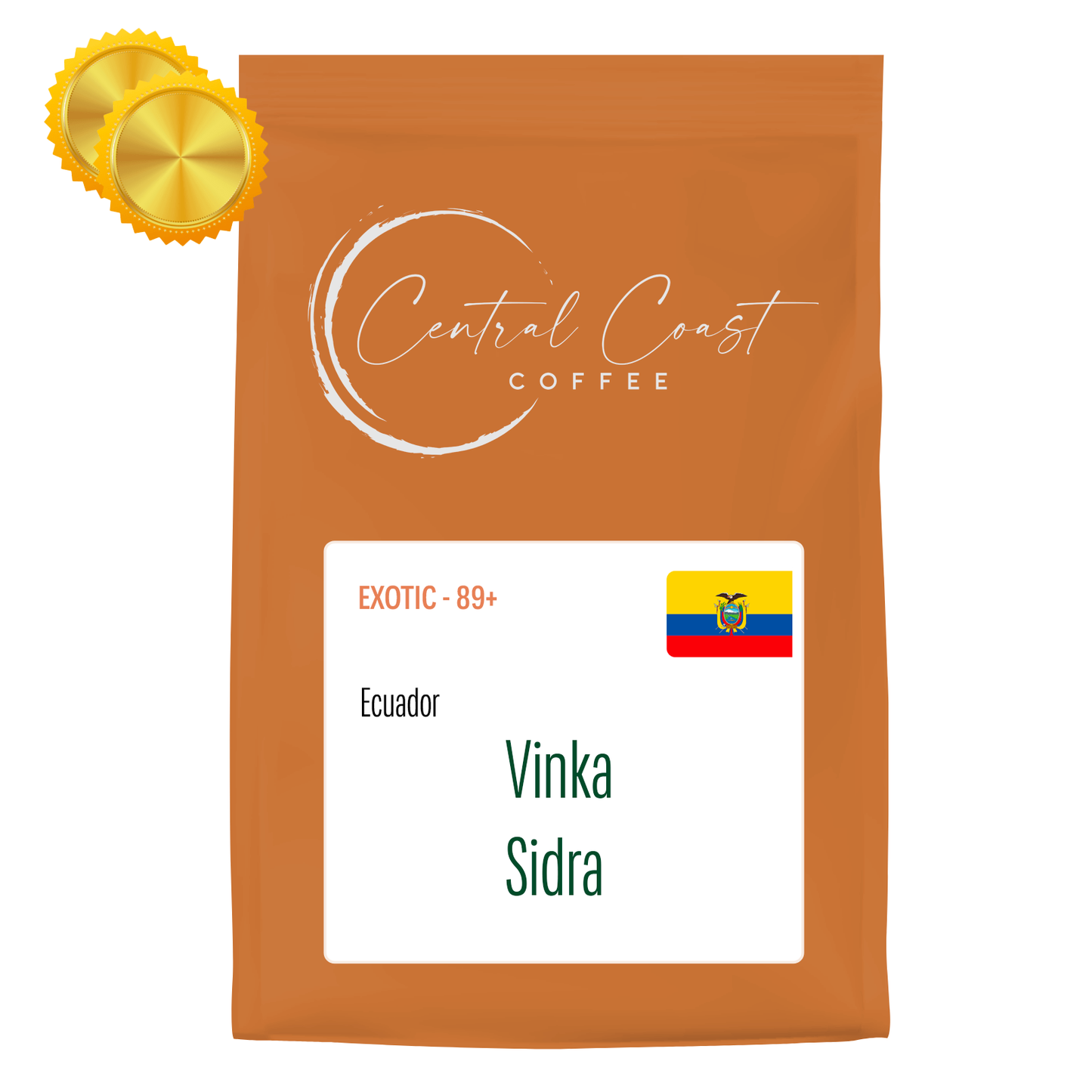
Origin and Sourcing
?
?
?
Roast Details
?
?
?
?
?
?
?
Taste Profile
?
?
Taste one coffee, six ways.
This is our first directly sourced coffee — grown, processed, and shipped by Maria and Carlos from Vinka Farm in Loja, Ecuador.
We’ve secured four distinct lots of their Sidra varietal, each processed differently: Natural Anaerobic, Natural Oxidation, Honey, and Lactic Honey. Same cherries, different methods — and four unique cup profiles that show just how much processing changes flavour.
Other Information
Growing Temperatures: 12-24°C
About Vinka Coffee
Vinka Coffee is grown by Maria Fernanda and Carlos, two university researchers turned passionate specialty coffee farmers. Their farm, nestled in the highlands of Loja, Ecuador, embodies a commitment to biodiversity, sustainability, and precision processing.
Each micro-lot is carefully hand-harvested at peak ripeness, with cherries measured at 25° Brix. These cherries undergo innovative processes—ranging from anaerobic natural fermentation to lactic fermentation—to unlock diverse flavor profiles.
About Sidra Varietal from Vinka
The Sidra varietal is a unique Ethiopian landrace, not a hybrid, making it a pure genetic descendant from Ethiopia's rich coffee heritage. Brought to Ecuador through a research initiative, it combines exceptional cup quality with the potential for high productivity.
Sidra has gained international recognition for its complex sensory profile, often described as floral and fruity, with hints of blueberry, lime, honey, and blackberries. It also features a distinct menthol note, rarely found in other coffees, which sets it apart and attracts specialty coffee buyers worldwide.
Producers and experts in Ecuador emphasize its outstanding agronomic traits: a medium-sized, robust plant with high germination rates, generous yields, and a stable, uniform behavior in the field. Its versatility shines across various post-harvest processes, unlocking diverse flavor expressions.
With its growing acclaim, Sidra is poised to become a flagship coffee variety, rivaling the reputation of Geisha, and positioning Ecuador as a producer of some of the world’s most exquisite coffees.
Coffee in Ecuador
Ecuador is quickly gaining recognition in the coffee world for its high-quality specialty coffee production. With a combination of diverse microclimates, fertile volcanic soil, and dedicated producers like Maria Fernanda and Carlos, Ecuador is redefining what coffee lovers can expect from South America.
Choose Your Process
Each process unlocks distinct flavour experiences, ensuring there’s a perfect cup for every coffee enthusiast:
1. Natural Anaerobic (SCA 89+)
Main Tasting Notes: Raspberry Mandarin Floral
Flavor Profile: Jasmine, ripe peach, mango, clove, fruit liqueur, bright citrus acidity, very clean, silky body, floral grapefruit, and a honey caramel finish.
Mouthfeel: Bright and vibrant, with pronounced citrus acidity and a silky body.
Description: This coffee shines with brilliant acidity and complex fruity and floral notes. A favorite for those who enjoy vibrant and clean cups with a bright finish.
How is it processed? The cherries are placed in a hermetic PVC tank to ferment in a CO2-rich, oxygen-free (anaerobic) environment. This occurs in the solid phase, meaning the cherries remain intact. During this process, the fermentation is exogenous, as sugar breakdown happens outside the cherry peel. Fermentation continues until the pH reaches approximately 3.9. Afterward, the cherries are dried on shaded, stacked beds until they reach a humidity level of 13%. Once dried, the cherries are stored until they are ready for export.
2. Natural Oxidation (SCA 87+)
Flavor Profile: Raspberry, blackberry syrup, cherry, lavender, caramel, with a refreshing mint finish.
Mouthfeel: Balanced with tartaric acidity, juicy body, and a harmonious sweetness-acidity profile.
Description: For those seeking balance, this process emphasizes a rounded, refreshing sweetness paired with juicy complexity.
How is it processed? The cherries are spread in a thin layer on raised beds to dry in the sun for 2–3 days. During this period, they are frequently moved to prevent fungal contamination. In this method, fermentation is endogenous, occurring inside the cherry under the peel while external oxygen helps to break down sugars. After this initial stage, the cherries are dried on shaded, stacked beds until they reach a humidity level of 13%. Once dried, the cherries are stored until export.
How do Anaerobic and Oxidation compare?
Oxidation is more balanced between acidity and sweetness, while anaerobic highlights acidity, a brilliant acidity!
The key difference between the Natural Anaerobic and Natural Oxidation processes lies in the fermentation environment. Anaerobic fermentation occurs in a CO2-rich environment outside the cherry, while oxidation fermentation takes place inside the cherry while they are exposed to oxygen.
3. Honey (SCA 85+)
Flavor Profile: Light, sweet, and easy-drinking with soft acidity.
Mouthfeel: Smooth and approachable with a gentle sweetness.
Description: This process brings out the natural sweetness of the Sidra variety. Ideal for those who love mellow, easy-drinking coffee that’s simple yet satisfying.
How is it processed? In this process, the cherries undergo fermentation similar to the Natural process. However, after fermentation is complete, the cherries are pulped, leaving some mucilage around the parchment. The pulped cherries are then dried on shaded, stacked beds until they reach a humidity level of 11%. The parchment beans are stored until ready for export.
4. Lactic Honey (SCA 85+)
Flavour Profile: Enhanced sweetness with vibrant acidity, tropical fruit notes, and a delicate caramel finish.
Mouthfeel: Creamy and rich, with a soft yet vibrant acidity.
Description: This innovative take on the Honey process uses lactic fermentation to amplify sweetness and acidity, resulting in a complex and indulgent cup.
How is it processed? Before harvesting, we prepare an inoculum of lactic acid bacteria endemic to our farm. (Plant-based inoculum produced from the same coffee cherries fermented during the natural process.) The cherries are then submerged in a saline solution to encourage the growth of lactic acid bacteria. Fermentation occurs in a liquid phase and continues until the pH reaches approximately 3.7. After this step, the process follows the same steps as the Honey process, with the cherries pulped and dried until they reach 11% humidity.
5. Washed Anaerobic (SCA 89+)
Main Tasting Notes: Papaya, Rasperry, Citris
Flavor Profile & Mouthfeel: Showcases clean and crisp acidity with floral notes and a delicate, refined sweetness." "This washed sidra has some impressively crisp acidity, with flavors ranging from citrus to raspberry to papaya.
This coffee is special, and a little pricy
How is it processed? After de-pulping, the parchment coffee, still covered by a thin layer of mucilage, is placed in a closed container for solid-phase fermentation driven by indigenous yeasts and lactic acid bacteria. The process continues until a pH of 3.8 is reached.
This Washed Anaerobic placed 6th place at the Ecudor Taza Dorada in 2024!!
6. Lactic Washed (SCA 85+)
Flavour Profile & Mouthfeel: Highlights smooth, creamy body with subtle citrus notes and a balanced, lingering sweetness.
How is it processed? After de-pulping, the parchment coffee, still covered by a thin layer of mucilage, is placed in a closed container and submerged in a medium inoculated with selected lactic acid bacteria. The fermentation proceeds until a pH of 3.5 is reached and the mucilage is completely degraded.
SKU: vinka_nat_160g
Package Weight: 200g
How does my coffee come packaged?
Despite some of our product images looking very fancy our coffee is packaged into a plain brown paper foiled lined bag with a Swiss WIPF degassing valve. This offers superior oxygen and moisture protection. We recommend once you crack the seal you store your coffee in AirScape containers or Weber Workshop Bean Cellars for a single dosing option.
You can also freeze/vacuum seal in small lots, then use straight away once removed from freezer.
We don't have fancy printed bags with ziplocks (more plastic), we save that cost and buy better quality green beans so you can focus on your cup quality instead of fancy marketing and artwork.

